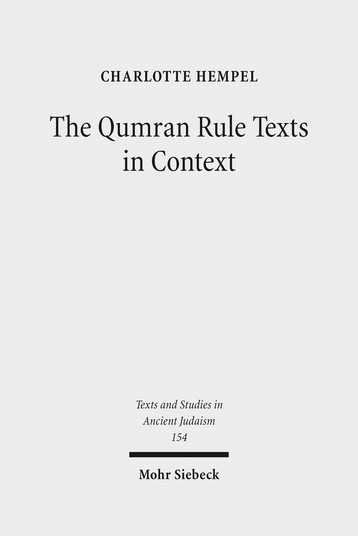Jewish Studies
Charlotte Hempel
The Qumran Rule Texts in Context
Collected Studies
[Die Regelliteratur von Qumran im Kontext. Gesammelte Studien.]
Also Available As:
Published in English.
Ever since the discovery of the Dead Sea Scrolls the Community Rule has been at the forefront of the scholarly imagination and is often considered a direct channel to life on the ground at Khirbet Qumran – an ancient version of 'reality television'. After the full publication of the Dead Sea Scrolls one might legitimately have expected that the complete spread of evidence would present us with most of the answers that we have been looking for. Instead, scholars increasingly recognize the significance of the Scrolls as a rich text world from a period when texts, traditions, interpretation, and scholarship laid the foundations of Western civilisation. While the literary, scribal, and textual aspects reflected in the Rule texts are becoming clearer, the social and community realities are becoming ever fuzzier. Ultimately the Scrolls present us with a complex and sophisticated collection of literature rather than a window into the inner workings of a group, let alone particular individuals. Such a scholarly trajectory mirrors the history of biblical scholarship and invites further dialogue between both fields. The studies by Charlotte Hempel gathered in this volume deal with several core Rule texts from Qumran, especially the Community Rule (S), the Rule of the Congregation (1QSa), the Damascus Document (D), and 4Q265 (Miscellaneous Rules) and uncover a complex network of literary and more murkily preserved social relationships. The author further investigates the Rule literature within the context of wisdom, law, and the scribal milieu behind the emerging scriptures. The volume ends with an exploration of the distinctive character of Qumran Cave 4, the home of the majority of Rule texts, as an eclectic collection of ancient Jewish higher learning.»These essays are essential reading for anyone interested in the Rulebooks found at Qumran.«
John J. Collins in Revue de Qumran 26 (2014), S. 483–485
»In truth, Hempel's volume is as much a commentary on the development, similarities, and differences between the Rule texts as it is an observation on the state and direction of Qumran Studies.«
Ian Werrett in Journal for the Study of Judaism 46 (2015), S. 443–445
